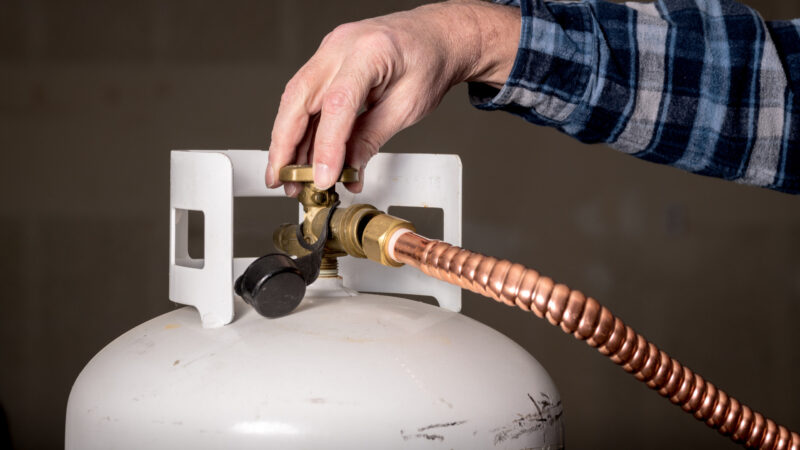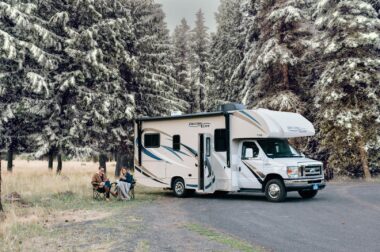Table of Contents Show
If you plan on spending time in your RV when the temperatures start dropping, you’ll want a working furnace. However, keeping comfortable in your RV in cooler temperatures can use a considerable amount of propane. Unless you enjoy constantly filling up small propane tanks, you’ll need to hook up an external propane tank to your RV.
Let’s take a look at how you can use an external propane tank to stay warm in your RV this winter. Let’s get started!
Can You Hook Up External Propane Tank to Your RV?
Hooking up an external propane tank to your RV is relatively easy and can be tremendously beneficial. This typically dramatically increases the amount of available propane, meaning you’ll have to worry less about running out of propane in the middle of the night.
Along with the external propane tank, you’ll need a propane regulator and adaptor kit to safely connect the tank to your RV.
External vs Onboard RV Propane Tanks
While most RVs come with onboard propane tanks, they’re typically small. If you rarely use your propane, you could get by for weeks or even months with 20 or 30 lb tanks. However, if you’re using propane to heat your RV during winter, these smaller tanks can be a pain to manage and refill.
Onboard RV propane tanks often mount to the RV’s frame itself. To refill these tanks, take your RV to the refill station. This may not be much of a hindrance if you’re moving from RV park to RV park. However, if you want to spend weeks or months at a campsite, you don’t want to pack up every time you need to refill your tanks. In that case, some propane fill services will come to you.
You’ll most often find onboard RV tanks on motorhomes. Travel trailers and fifth wheels typically use external tanks. Both tank types serve the same purpose of supplying the RV with propane. You won’t have much choice when it comes to which tank types come with your RV, as the manufacturer runs lines and mounts the tanks for you during manufacturing.
Pro Tip: Have you ever wondered if you should travel with your RV propane tanks open or closed? Find out now.

Types of RV Propane Tanks
There are two common types of RV propane tanks–ASME and DOT. These tanks come in varying sizes and connect to the RV so you can use a refrigerator, water heater, or stove.
American Society of Mechanical Engineers, or ASME, propane tanks typically mount permanently to the RV. These tanks come in various sizes and use gallons to measure their contents. These tanks range in size from 120 gallons to 2,000 gallons.
You might see these tanks in homes and other places that use propane for heating. However, motorhome manufacturers often choose this tank type to mount to the vehicle’s frame. This often requires taking the entire motorhome to the refill station or having a propane service come to your location to refill the tank.
The other common type of RV propane tank is a DOT propane tank. These tanks are easy to move from location to location and are typically smaller tanks. You’ll often see them powering grills, portable heaters, and other appliances. These tanks are measured in pounds and typically range in size from 5 lbs to 420 lbs. These tanks are more convenient to refill as you can load up the empty tank and take it to the refill station without bringing your entire RV.

What You Need to Hook Up an External Propane Tank to Your RV
Connecting an external propane tank to your RV isn’t difficult, but it requires a few items. Make sure you acquire the items in advance to eliminate any potential frustrations or delays.
External Propane Tank with Regulator
If you’re hoping to connect an external propane tank to your RV, you’ll need an external propane tank. In some cases, it may be better to rent this instead of purchasing it. Many RV parks and propane distributors will rent you the tank as long as you refill it at their onsite fill station.
The tank will need a regulator to reduce the gas pressure as it travels to your various RV appliances. If the tank doesn’t come with one, you’ll need to purchase one to avoid issues with your RV’s propane system.
Pro Tip: We can help narrow your search with our list of the best RV propane regulators.
External Propane Tank Adapter – Extend-a-Stay Kit
- Includes propane tee.Fit Type: Universal Fit
- Includes 5' auxiliary tank hose and 12' additional appliance hose
You’ll need an adapter to hook up your external tank to your RV’s propane system. If you choose this kit, it has everything you need to easily accomplish the task.
The 4-port propane tee connects an external propane tank and other appliances to your RV’s propane system. It also comes with caps that prevent accidental loss of propane from the unused ports.
We love that this kit also includes two additional hoses, so you have plenty of hose length for your connections.
Optional: Additional Propane Hose
It’s wise to have an additional propane hose or two on hand. This can be useful if you develop a leak in your hose or need extra length when placing your external propane tank.
You might think this is an unnecessary purchase. But isn’t having an unused extra hose better than needing one and not having one?
Soapy Water Spray Bottle
One of the best ways to check your propane hoses and connections for leaks is by spraying them with soapy water. The mixture of soap and water will bubble if there’s any sign of air escaping. Leaks in your propane system can come from pin-sized holes that are practically invisible to the human eye. This step is essential for your safety and the efficiency of your rig.
How to Hook Up External Propane Tank to RV in 4 Steps
If you don’t know how to hook up an external propane tank to your RV, we’re here to help. We’ve broken it down into four easy steps that practically anyone can do. Let’s take a look!
1. Turn Off Propane and Install Extend-a-Stay Kit to Your Onboard Propane Tank
Anytime you’re making any adjustments to your propane system, always shut off the flow of propane first.
Look at the knob on the top of the propane cylinder and turn the dial in the proper direction to close it. You can then install the extend-a-stay kit to your onboard propane tank without having to worry.
2. Install Regulator to External Propane Tank
After installing the extend-a-stay kit to your onboard tank, it’s time to put the propane regulator on your external propane tank. This regulator will reduce the pressure from the high-pressurized tank as it enters your propane system.
Check for a tight connection to avoid potential leaks. Test the connections with a firm but careful hand, so you don’t damage the regulator or the external propane tank.
3. Connect Extend-a-Stay Kit to External Tank
With everything ready to go, you can now connect the extend-a-stay kit to your external tank. Hopefully, you’ve verified that you have enough hose length on hand to reach the external tank. If not, you’ll soon be making a trip to a local hardware store to get a longer hose. Again, tighten all connections, but not too tight.
4. Turn on Propane and Check All Connections with Soapy Water
With everything connected, you can now turn on all of your propane tanks. Before checking off this task as complete, you should spray soapy water on all the connections. As we mentioned earlier, this mixture will bubble up around any leaks in the system. If you see bubbles or smell propane, immediately shut off the connection and address the issue.

Is It Safe to Use an External Propane Tank on Your RV?
When properly connected, an external propane tank is just as safe as an onboard propane tank. The system in an RV is almost identical to residential and commercial systems.
That being said, be cautious. If you smell propane or discover a leak, always shut off the propane immediately. Don’t wait to look into the issue, or you could create a hazardous situation.
If you take the proper steps, propane is an incredibly efficient and effective way to heat your RV, and you might enjoy having the external tank on hand.
Stay Warm This Winter with Plenty of Propane Options
Using propane to heat your RV is an incredibly efficient and economical way to stay warm while in your RV. Propane is readily available throughout the country, and you can even have a propane service come to you.
We love RVing in colder weather for the unique experiences you can have. You can visit some of the greatest locations in the world without battling large crowds.
Do you plan to use your RV in colder conditions? What does your propane situation look like?
Last update on 2025-06-27 / Affiliate links / Images from Amazon Product Advertising API







